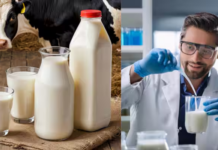While delivering the Keynote address at the 45th Dairy Industry Conference with the theme Climate Change & Dairying organised by the Indian Dairy Association (IDA) on 16 February, 2017, Shri Dilip Rath, Chairman, National Dairy Development Board said that animals are a regular source of cash income and an asset, which can act as an insurance against income shocks of crop failure and natural calamities.
Shri Rath said that there are primarily 3 contributing factors which led to the remarkable growth of Indian dairy sector taking our country from a period of deficit four to five decades ago to one of self-sufficiency now. First is the steady growth in agricultural production which made it possible to make available adequate feed and fodder to the animals. Second is our cross breeding strategy which ensured retention of the climate resilient traits of our native breeds. And above all, thirdly the powerful role played by farmer owned and controlled institutions which provided market access to millions of small holders.
Chairman NDDB said that climate patterns and resource endowments have significant implications for agriculture and livestock since parameters such as temperature, humidity, rainfall affect water and other resources and thereby agriculture and livestock. The dairy sector is likely to be affected both directly and indirectly by climate change. While stress to animals caused by changes in temperature-humidity index would directly affect milk production and animal reproduction, indirect effects include feed and water availability being impacted by adverse climate events.
Highlighting research findings, Shri Rath informed that stress from heat can cause decline in milk yield in the range of 10 to 30 % in first lactation and 5 to 20 % in second and third lactation, and that both the heat waves and cold waves can cause short to long term cumulative heat effect on milk production in cattle and buffaloes. Heat stress can also impact animal reproduction adversely as levels above the acceptable levels can impact conception rates. Stressful heat can also reduce blood flow to uterine tract and damage developing embryos as well as impact semen quality.
According to Chairman NDDB, climate change can impact the frequency and extent of outbreaks of infectious diseases like FMD and HS as well as cause new transmission modes which can be aided by reduced immunity levels due to inclement conditions. While increased temperatures can increase rate of growth of pathogens outside their host, altered humidity levels can affect those sensitive organisms and changes in wind patterns can affect the spread of diseases. Increased temperatures can result in increased usage of water by animals both for drinking and any usage for cooling the animal.
He said that indigenous breeds have genetic traits that help them to survive with in harsh climates, pursuing breeding policies that encourage an appropriate mix of breeds that can adapt to the region in which they are to be kept, should be the most important element in our adaptation strategy. Under National Dairy Plan (NDP) I – a programme under implementation by NDDB, indigenous breed development programmes for eleven breeds – Kankrej, Rathi, Gir, Sahiwal, Hariana and Tharparkar breeds of cattle and Murrah, Mehsana, Nili Ravi, Jaffarabadi and Pandharpuri breeds of buffaloes are being implemented in their respective native tracts through a scientific selection programme.
Shri Rath informed that the ultimate objective of the United Nations Framework Convention on Climate Change (UNFCCC) is stabilizing greenhouse gas concentrations in the atmosphere at a level that would prevent dangerous anthropogenic interference with the climate system. India’s gross emissions of Greenhouse Gases was estimated at 2.136 billion tonnes in CO2 equivalent in 2010, of which the energy sector contributed 71%, industrial product and process use – 8%, agriculture – 18% and waste sector – 3%. After the offset by carbon sink action of forests and croplands, the net emissions is about 1.884 billion tonnes of CO2 equivalent. Of the 0.39 billion tonnes of CO2 equivalent from agriculture in India, about 58% (0.23 billion tonnes) is from enteric fermentation from livestock.
While India’s dairy sector accounts for 18.3% of global milk production, its contribution to GHG emissions is only 14.1 %. Ways in which we can either avoid increasing the emission intensity or reduce the emissions of greenhouse gases are – Improving productivity of our animals, adopting a predominantly crop residue based feeding pattern, adopting a mixed crop livestock production system, encouraging producers to feed a balanced ration and adopt renewable energy in the dairy value chain. NDDB has also been encouraging dairies in the cooperative network to adopt renewable energy.
Shri Rath conveyed that as climate change is a challenge that impacts all of us, our dairy sector must not only evolve adaptation strategies but also help in mitigation by contributing to reduction in greenhouse gas emissions from the dairy sector. NDDB

































